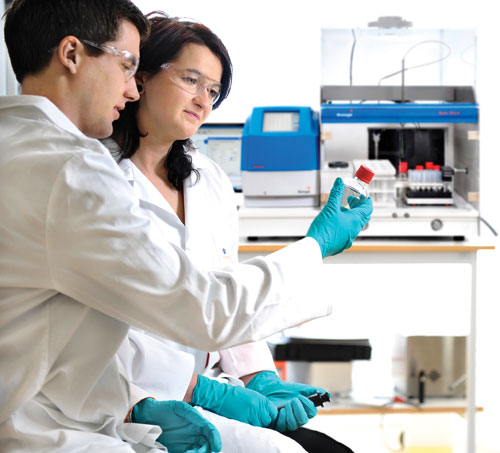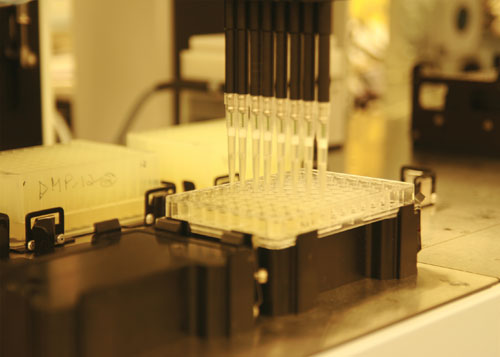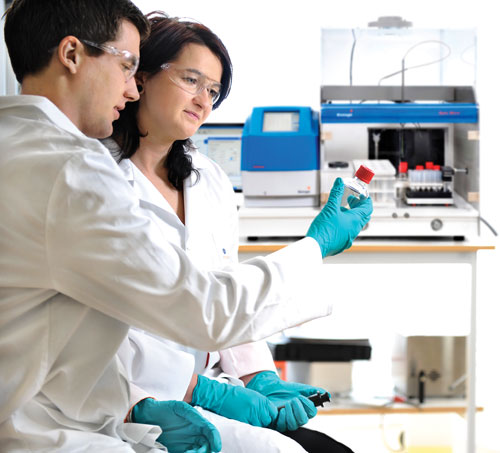July 1, 2016 (Vol. 36, No. 13)
Angelo DePalma Ph.D. Writer GEN
Peptide Drugs Are Not Only Diverse and Manufacturable, They Are Also More Available Via the Oral Route
Peptide drugs have gone in and out of fashion during the last 30 years. With manufacturability and discovery largely solved, success will depend in large part on overcoming issues related to formulating and delivering these promising agents in oral form.
Christopher A. Rhodes, Ph.D., president and CEO at consulting firm Drug Delivery Experts, notes that successful oral peptide drugs have evolved by using both old and new technologies.
Classically, the way to improve bioavailability of peptides has been through permeability enhancement. These techniques disrupt the bilayer in the gut, which permits drugs to pass rapidly into the vast vasculature underneath. “The problem with those methods is they deliver a pulsatile dose,” Dr. Rhodes says.
This works for some drugs but not those that require long exposure time to achieve therapeutic effectiveness. He notes that top pharmaceutical companies have
applied permeability enhancement but failed to achieve bioavailability of more than 2% (a good example is salmon calcitonin that is currently in Phase III and has been under development by Tarsa Therapeutics, and predecessor companies for almost 20 years).
But Novo Nordisk’s semaglutide, the oral GLP-1 analog currently in Phase II, utilizes this technology (as well as injection) effectively because the drug has a long circulating half life—more than one week. Despite less than 1% of the drug entering the bloodstream, its in vivo stability means that the drug need not be dosed exactly at the time of the meal to provide sufficient exposure for maximum efficacy, typically required for the GLP-1s to be effective.
“The combination of long exposure and permeation enhancement makes this peptide and old oral delivery technology combination very promising,” says Dr. Rhodes, noting that sponsor Novo Nordisk plans to take weekly injectable and oral dosage forms of semaglutide into Phase III.
Permeation Enhancement
Permeation enhancement has been the principal strategy for turning poorly absorbed drugs into successful products. It works adequately well for some newer peptide drugs, which tend to be lower in weight (1000 to 2000 Da) and thereby absorb more efficiently than larger peptides.
Cara Therapeutics’ opioid agonist, CR845, uses permeation-enhancement technology from Enteris, a peptide/protein oral delivery specialty firm, and incidentally the company that holds the drug delivery technology that is used in the Tarsa Therapeutics program. The Cara drug recently completed Phase II testing for acute and chronic pain.
“There’s nothing special about permeation enhancing technology,” notes Dr. Rhodes. It has been around for some time. It can be useful if used with the right peptide properties.
A newer strategy (but still old technology) involves embracing the low systemic absorption of peptides. For example, peptides treating inflammatory bowel disease and colitis where the disease exists on the inside of the gut wall.
An added benefit for these gut-based diseases is that systemic exposure is minimal, thereby minimizing side effects. Ironwood Pharmaceuticals’ linaclotide, an example of this strategy, has been approved for irritable bowel syndrome. Blood levels of linaclotide are undetectable.
The newest approach to oral delivery of biologics comes from a device-based approach, namely dissolving microneedles. Rani Therapeutics and an MIT consortium of engineers, separately, use this approach.
Rani uses sugar-based microneedles that stabilize peptides within the microneedles, which are delivered through a standard oral delivery gelatin capsule. The capsule has an enteric coating that opens in the upper gastrointestinal tract at pH 5–7, which pushes needles into the intestinal wall. As they dissolve they release the drug. Bioavailability is around 50%, which while lower than the 90% provided by subcutaneous injection, is an order of magnitude better than the best available permeability enhancer. Rani uses this technology with parathyroid hormone, a GLP-1 analog, interleukin 17, and a half dozen other biologics.
“Rani appears to have solved two of the three major hurdles for oral biologics delivery, stability in the GI tract (sugar formulation is quite stable), and limited permeability of biologics,” according to Dr. Rhodes.
Microneedles are still an early-stage idea whose manufacturability, safety, and tolerability must still be demonstrated.
Solving the Numbers Game
Ra Pharma has developed a technology that adds a new dimension to the concept of peptide libraries, enabling it to develop drug candidates with the diversity and specificity of antibodies and the bioavailability of small molecules. Rather than simply generating collections of short peptides from natural amino acids, the company creates huge assemblies representing every possible combination of amino acids for a given peptide length.
For example a 10-mer using all combinations of the 20 natural amino acids can be represented by 10 trillion individual molecules. The technique also allows the production of cyclic molecules and peptides containing backbone modifications and unnatural amino acids.
“We build into our libraries up-front the features that are critical for good bioavailability, stability, and potency of peptides,” says Douglas Treco, president and CEO. “We can create libraries that allow selection of peptides that are structurally and physicochemically more related to drugs and useful natural products.”
The technology, pioneered by Massachusetts General Hospital researcher, Nobel Laureate, and Ra co-founder Jack Szostak, Ph.D., uses ribosomes to make peptides containing natural and unnatural amino acids. 100 trillion-member peptide libraries in a test-tube are possible. “The numbers are much higher than you could expect from phage display or any other technology,” Treco comments.
The process begins by constructing DNA libraries containing all codon combinations for the desired length, transcribing the DNA to RNA, and feeding that product to the ribosomes.
The trick is to get ribosomes to translate mRNA into a peptide and physically link it to the original mRNA. One trillion mRNA molecules equals 1 trillion peptides. “They’re all floating around in a test tube but you have to fish out the ones you want,” Treco notes.
This is done by exposing the assembly of new peptide-RNA complexes to an immobilized, physiologically relevant target. RNA molecules that bind to the target are amplified by polymerase chain reaction, sequenced, and the associated peptide is synthesized through conventional solid-phase synthesis. The process uses affinity to pull out putatively active peptides, based on no a priori knowledge of what the peptide looks like.
To produce peptides to assay and study, chemical synthesis is significantly more efficient than re-introducing amplified mRNA to ribosomes and having the organelles do the work. Ribosomal translation is not that efficient. “Plus, one of our goals was to avoid biological manufacturing,” points out Treco.
The question of “unnatural” amino acids here is relevant. Ra focuses largely on side-chain and backbone-modified building blocks, for example containing N-methylated species, replacing nitrogen with oxygen to create heterocyclic side-chains, or using fluorinated side-chains. Ra’s technique allows the efficient construction of cyclic peptide libraries as well.
“We’re finding peptides with extraordinary potency, stability, and bioavailability coming right out of our libraries,” says Treco.

Automated room-temperature peptide synthesizers and microwave peptide synthesizers provided by Biotage come in various sizes and evince different degrees of sophistication, from entry-level to high-throughput configurations.
Production Issues Overcome
Peptide production services, which all rely on automated synthesizers, are amply available to drug discovery and development organizations.
Biotage manufactures room-temperature peptide synthesizers and microwave peptide synthesizers in manual, semi-automated, and fully automated formats. John Urh, regional market manager for the Americas, notes that instrument sales are flat or at best growing slowly. Worldwide sales of peptide synthesizers totals between 300 and 400 units annually. Considering the number of organizations with peptide drug programs, and assuming an approximately 50/50 academic/industrial split, those numbers aren’t so bad.
Most experts interviewed in this article note an uptick of interest in peptide drugs, particularly at large drug companies. Merck has established a peptide effort; Novartis and AstraZeneca have stepped up their programs, according to Urh.
One factor that may underestimate overall interest, particularly at universities and research institutes, is the presence of cheap labor (i.e., post-docs and grad students), which makes synthesis by hand through traditional solution chemistry more attractive than instrument-based synthesis.
On the topic of unnatural amino acids, Urh mentions beta-peptides as growing in popularity. These molecules contain an extra carbon between the carboxylate and amino groups. “They can be formed more easily into cyclic peptides,” Urh says, with enhanced pharmacologic and delivery properties.
Also popular are “lollipop” structures composed of a cyclic molecule with a polypeptide tail. Oxytocin, which is used to induce labor, is just one example of a commercially successful lollipop peptide.
Thermo Fisher Scientific’s peptide production business may not be well known to readers, but it operates at the forefront of custom, research-use synthesis services. Peptide synthesis is part of the firm’s mass spectrometry reagents unit and serves a broad range of projects —about half in industry, half in academic or institute organizations.
“We’re seeing a spike in immunology and drug discovery applications, both from academic and industrial organizations,” says Kelsey Song, project specialist.
Thermo’s strength is stable isotope peptides which, with the availability of exquisitely sensitive MS, have replaced radionuclides in a majority of life science applications. The company’s HeavyPeptide™ AQUA products show high accuracy in quantitation studies. The workhorse isotope is 13C, whose presence is easily discerned in peptides and their metabolites from the much more abundant 12C. The company also provides labeled or unlabeled peptide libraries and individual high-purity peptides.
Capabilities include more than 400 modifications of standard peptides, including L-amino acids, sidechain alterations, and CAM and Phospho variants. CAM adds stability to unoxidized cysteine residues, while Phospho phosphorylates oxygen-containing amino acids such as threonine, tyrosine, and serine.
Ya Chen, Ph.D., a scientist at peptide specialty firm LifeTein, explains that with the growing pipeline of peptide drugs, diagnostics, and research reagents business is booming. The well-known problem of degradation in the gut limits the effectiveness of many peptide drugs, but modifying side chains serves as a good work-around for some molecules. “Modified peptides have better resistance to both chemical and enzymatic degradation,” says Dr. Chen.
Aside from common side chain modifications (“unnatural” amino acids), LifeTein produces enantiomers which, according to Dr. Chen, are not in high demand these days. Other mods include phosphorylation or glycosylation on threonine and serine, cyclic peptides, and fluorescent tags for following peptides inside cells.
LifeTein is a research-only provider, not a cGMP shop. For drug development that is further along the regulatory pathway Bachem, GenScript, and PolyPeptide offer their services.
LifeTein has overhauled the entire peptide product process and developed a proprietary method that delivers purified peptides of typical length in 3–5 days versus several weeks. High-purity product takes about one week. “Our record is 159 residues, which took a month,” says Dr. Chen.

LifeTein, a custom peptide synthesis service company, deploys solid-phase peptide synthesis and hybrid technology to generate long peptides. As this image indicates, the company stays on top of peptide production runs by making use of automated liquid- handling systems.







